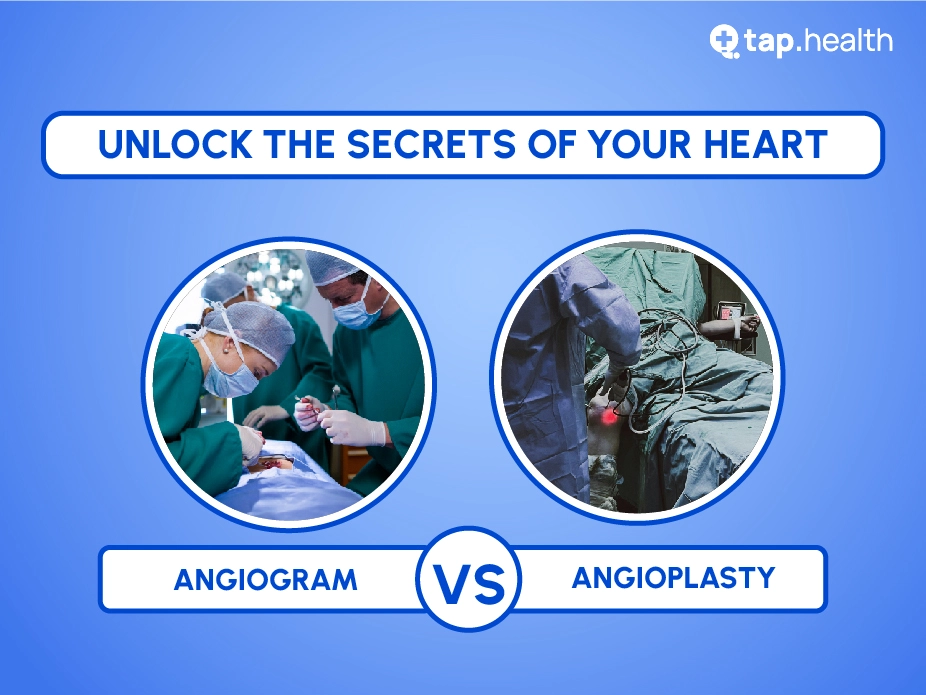Cardiovascular health is critical, and procedures like angiogram and angioplasty play vital roles in diagnosing and treating heart-related conditions. While both are essential in managing cardiovascular diseases, they serve distinct purposes. This article breaks down the differences between angiogram and angioplasty, covering their definitions, purposes, procedures, risks, and recovery processes in a clear and concise format. Whether you’re a patient or simply curious, understanding these procedures can help you make informed decisions about heart health.
What is an Angiogram?
Definition: An angiogram is a diagnostic imaging procedure that uses X-ray technology and a contrast dye to visualize blood vessels. It helps identify blockages, narrowing, or abnormalities in vessels supplying organs like the heart, brain, or kidneys.
Purpose:
- Diagnose conditions such as coronary artery disease, peripheral artery disease, or aneurysms.
- Assess blood flow and detect vascular abnormalities to guide treatment plans.
Procedure:
- A catheter is inserted into a blood vessel (often in the groin or arm).
- Contrast dye is injected to highlight blood vessels on X-ray images.
- The medical team captures images to evaluate vessel structure and function.
- The catheter is removed, and pressure is applied to prevent bleeding.
Key Notes: Patients must remain still during imaging to ensure clear results. Sedation or local anesthesia is often used for comfort.
What is an Angioplasty?
Definition: Angioplasty is a therapeutic procedure to widen or unblock narrowed blood vessels, typically using a balloon-tipped catheter. A stent may be placed to keep the vessel open.
Purpose:
- Restore blood flow in arteries affected by plaque buildup.
- Treat conditions like coronary artery disease or peripheral artery disease.
- Alleviate symptoms and prevent complications like heart attacks.
Procedure:
- A catheter with a deflated balloon is inserted into the affected artery.
- The balloon is inflated to compress plaque and widen the vessel.
- A stent may be placed to maintain vessel openness.
- The balloon is deflated, the catheter is removed, and the insertion site is sealed.
Key Notes: Angioplasty is minimally invasive, offering quicker recovery compared to open surgery. It’s often performed after an angiogram confirms a blockage.
Why Are These Procedures Performed?
Why an Angiogram?
An angiogram is performed to:
- Identify blockages or narrowing in blood vessels.
- Diagnose cardiovascular conditions like atherosclerosis or aneurysms.
- Guide treatment decisions, such as whether angioplasty or surgery is needed.
Common Conditions Diagnosed:
- Coronary artery disease
- Peripheral arterial disease
- Aneurysms
People Also Ask: What does an angiogram show? An angiogram reveals the condition of blood vessels, highlighting blockages, narrowing, or structural abnormalities to aid in accurate diagnosis.
Why an Angioplasty?
Angioplasty is performed to:
- Restore blood flow in blocked or narrowed arteries.
- Relieve symptoms like chest pain (angina) or leg pain from poor circulation.
- Reduce the risk of heart attack or stroke.
Common Conditions Treated:
- Coronary artery disease
- Peripheral artery disease
- Blocked arteries due to plaque buildup
People Also Ask: What is the purpose of angioplasty? Angioplasty opens narrowed or blocked arteries to improve blood flow, alleviate symptoms, and enhance cardiovascular health.
How Are Angiogram and Angioplasty Performed?
Angiogram Procedure Explained
- Preparation: Patients receive sedation or local anesthesia for comfort.
- Catheter Insertion: A catheter is inserted into a blood vessel (groin or arm) and guided to the target area using X-ray imaging.
- Dye Injection: Contrast dye is injected to make blood vessels visible on X-rays.
- Imaging: X-ray images are taken to assess blood flow and vessel condition.
- Completion: The catheter is removed, and the insertion site is compressed to prevent bleeding.
Patient Tips: Stay still during imaging and follow pre-procedure instructions, such as fasting.
Angioplasty Procedure Explained
- Preparation: Similar to an angiogram, sedation or anesthesia is used.
- Catheter Insertion: A catheter with a deflated balloon is guided to the blockage.
- Balloon Inflation: The balloon is inflated to compress plaque and widen the artery.
- Stent Placement (if needed): A mesh tube (stent) is placed to keep the artery open.
- Completion: The balloon is deflated, the catheter is removed, and the site is sealed.
Patient Tips: Vital signs are monitored closely during the procedure to ensure safety.
People Also Ask: How long does an angiogram or angioplasty take? An angiogram typically takes 30–60 minutes, while angioplasty may take 1–2 hours, depending on complexity.
What Are the Risks and Complications?
Risks of an Angiogram
While generally safe, angiograms carry some risks:
- Allergic reaction to contrast dye (especially in those allergic to iodine or shellfish).
- Bleeding or bruising at the catheter insertion site.
- Blood vessel damage or infection.
- Kidney damage from contrast dye (rare).
Prevention Tips: Inform your doctor of allergies and follow post-procedure care to minimize risks.
Risks of an Angioplasty
Angioplasty shares similar risks with angiograms, plus:
- Vessel injury, dissection, or rupture (rare).
- Restenosis (re-narrowing of the artery).
- Blood clots or stent complications.
Prevention Tips: Adopt a heart-healthy lifestyle (e.g., quit smoking, eat a balanced diet) and attend follow-up appointments to monitor recovery.
People Also Ask: Is an angiogram or angioplasty dangerous? Both procedures are generally safe but carry minor risks. Discuss concerns with your doctor to weigh benefits and risks.
What Is the Recovery Process?
Post-Angiogram Care
- Monitoring: Patients are observed for a few hours to check for complications.
- Insertion Site Care: Keep the area clean and dry to prevent infection or bleeding.
- Activity Restrictions: Avoid strenuous activities for a few days.
- Hydration: Drink plenty of fluids to flush out contrast dye.
Recovery Time: Most patients resume normal activities within a few days.
Post-Angioplasty Care
- Monitoring: Patients may stay in the hospital for a few hours or overnight.
- Medications: Anti-clotting drugs or other medications may be prescribed.
- Lifestyle Changes: Follow a heart-healthy diet, exercise as advised, and quit smoking.
- Follow-Ups: Regular checkups monitor artery health and stent function.
Recovery Time: Rest for 1–2 days, with full recovery in a few weeks, depending on the case.
People Also Ask: How long is recovery after angioplasty? Most patients recover fully within a few weeks, but activity restrictions may apply initially.
Key Differences Between Angiogram and Angioplasty
| Aspect | Angiogram | Angioplasty |
|---|---|---|
| Purpose | Diagnostic (visualizes blood vessels) | Therapeutic (widens blocked arteries) |
| Procedure | Uses contrast dye and X-rays | Uses a balloon catheter and possibly a stent |
| Invasiveness | Minimally invasive | Minimally invasive |
| Recovery Time | A few days | A few weeks |
| Risks | Allergic reactions, bleeding, kidney damage | Vessel injury, restenosis, blood clots |
People Also Ask: Can an angiogram and angioplasty be done together? Yes, if an angiogram reveals a blockage, angioplasty may be performed immediately to treat it.
Conclusion
Angiogram and angioplasty are cornerstone procedures in cardiovascular care. An angiogram diagnoses vascular issues by visualizing blood vessels, while angioplasty treats blockages to restore blood flow. Both are minimally invasive, but they differ in purpose, procedure, and recovery. Understanding these differences empowers patients to make informed decisions and follow proper aftercare for optimal heart health. Always consult your healthcare provider for personalized advice and to address any concerns.



